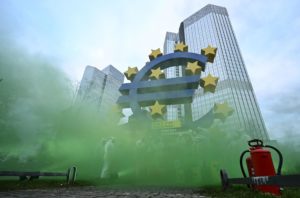Taxonomy is a dry, technical word for a classification system but, when used by the EU as part of its efforts to achieve net-zero emissions by 2050, it is a term that has triggered passionate debate. The EU Taxonomy, in short, defines and classifies which economic activities can be labelled as “green”, to qualify for EU funding. After it was first proposed in March 2019, the debate about what to include in the taxonomy quickly became one about EU member states’ national interests.
China and the EU after the pandemic
Read more from this series, in which we compare the post-Covid policies of China and the European Union, and how their relationship is evolving
The main sticking point has been over fossil-fuel gas and nuclear energy. Pragmatists concerned about energy security have argued for their inclusion, while environmental campaigners have objected that this would contradict the EU’s net-zero emissions strategy. As the year-end deadline for a decision approached last month, fears that the European Commission would allow their inclusion had been such that environmental activists gathered in Brussels to stage a mock funeral for it. Their fears proved well founded, as on New Year’s Eve the commission published draft proposals allowing the inclusion of gas and nuclear, under certain conditions.
So, what’s it all about? The EU Taxonomy, according to a European Commission document, is “a tool to help investors, companies, issuers and project promoters navigate the transition to a low-carbon, resilient and resource-efficient economy.” The aim is to “protect private investors from greenwashing, help companies to become more climate-friendly, mitigate market fragmentation and help shift investments to where they are most needed”. As such, it is central to the EU’s broader aim of reaching net-zero emissions by 2050.
Environmental objectives
The EU Taxonomy strategy sets six environmental objectives: mitigating climate change (mainly through decarbonisation); adapting to climate change (managing the physical risk); protecting water and marine resources; transitioning to a circular economy; preventing and controlling pollution; and protecting and restoring biodiversity and ecosystems. Each of these objectives covers a range of economic activities. The climate change mitigation section alone covers 90, each of which has “technical screening criteria” to determine whether any revenue or capital expenditure incurred from the activity can be considered green.
The system is designed to be flexible, to encourage companies to adopt its rules. Apart from the activities that are more obviously green, such as the manufacture of solar panels and wind turbines, the EU Taxonomy also sets criteria for “transitioning” activities; in other words, for those companies working towards meeting the green definition. For example, the manufacture of cement has always been a highly carbon-intensive industry, but if the CO2 emitted in the process can be reduced to below a certain threshold set by the EU Taxonomy, then it can be considered green. This would be important to a cement manufacturer because, with these green credentials, it can then access attractively priced Green Deal funds to finance its business.
Thus, simply by defining which activities are green and setting the standards to be met, the EU Taxonomy effectively decides which sectors and companies get green funding, incentivising them to remain on the path to net zero. The EU itself, as well as other governments and agencies, will also be using the taxonomy criteria in the financial markets for their risk assessments and for their green bond programme. Asset managers handling pension and other investment funds will likewise be looking to follow the taxonomy when they decide which companies to invest in. Directly applicable to them, too, is the Sustainable Finance Disclosure Regulation, which requires them to report on how much of their revenue comes from investments in green companies.
A further element of flexibility in the system comes with the taxonomy’s review process, as the criteria are set to be reviewed every three years, after which they can be adjusted as necessary. For environmentalists, however, the EU Taxonomy has seen far too much flexibility already – so much, they say, as to potentially undermine its whole purpose. As the WWF declared in a statement released to coincide with the mock funeral staged in Brussels last month: “Billions of euros are at risk of being diverted into fossil fuels, nuclear energy and factory farming, worsening the climate and nature crises. This is because the EU Taxonomy is probably about to be greenwashed.”
A politicised debate
The EU Taxonomy, as well as being an environmental measure, has become an intensely political question for EU member state governments, now under pressure from their electorates over soaring energy prices, increased living costs and fears of energy blackouts. In early 2021, the French government gave their backing to new nuclear projects. But as they wanted nuclear to be included in the taxonomy, France had to do a deal with Germany, which instead wanted the inclusion of gas, having moved to decommission all its nuclear reactors following the Fukushima disaster.
As Energy Monitor said: “it now appears that a nuclear-for-gas compromise may be the only way to get the taxonomy through a vote in the EU Council.” If that were to happen, the WWF said, “it will deal a fatal blow to the taxonomy. The consequences for the EU Green Deal, the EU’s sustainable finance leadership, and the climate and nature crises would be dire.”
Climate change thinktank E3G says such a move would contradict the EU’s regulatory process and principles, entail reputational damage and a loss of trust, effectively handing its current regulatory leadership role on climate issues to China.
EU Taxonomy lags behind
Developments in the EU Taxonomy debate are being closely watched by regulators and investors around the world. China’s own taxonomy is known as the Green Bond Endorsed Project Catalogue. It excludes gas, liquid natural gas and coal, and so sets the highest green energy finance standards. This taxonomy is mainly used by financial institutions and corporations for the issuance of green bonds in the Chinese onshore markets, with different disclosure requirements for different types of green bonds.
China and the EU have conducted an in-depth comparison of their respective systems, which has resulted in the Common Ground Taxonomy. This could in time form the basis of a possible global standard for sustainable finance, usable by other countries wanting to develop their own green taxonomies.
Russia’s taxonomy also restricts investment in new gas projects, closely reflecting the EU’s original proposals. South Korea, meanwhile – sensing that the EU Taxonomy is in trouble – seems to be back-tracking on its own standards. According to E3G, the Korean environment ministry has explained that the continued debate over this issue in Europe has influenced their decision not to exclude unabated gas power from its ‘green’ list, although nuclear power is still excluded.
Japan is struggling to live up to the pledges it made at COP26 in Glasgow last November, such is its concern about energy supplies. According to Bloomberg, Japan’s prime minister, Fumio Kishida, approved a strategic energy plan on 22 October, before the COP, which says: “no compromise is acceptable to ensure energy security, and it is the obligation of a nation to continue securing necessary resources.” The US and UK have already said they will draft their own taxonomies in due course.
The taxonomy cannot ban investments in polluting activities. It is meant as a transparency tool.Tsvetelina Kuzmanova, a policy adviser on sustainable finance at E3G’s Brussels office
Back in Europe, the reality is that the taxonomy debate has been skewed by serious misconceptions and a lack of understanding, being focused on national interests rather than long-term goals or vision, says Tsvetelina Kuzmanova, a policy adviser on sustainable finance at E3G’s Brussels office.
As she told China Dialogue: “The taxonomy cannot tell you what to invest in. It cannot ban investments in polluting activities. It does not even apply to member states’ own spending or budget – it is meant for private finance disclosure requirements as a transparency tool. If anyone is willing to invest in unsustainable activities, that is their decision. But [the taxonomy] should not justify greenwashing and thus undermine the legitimacy and trust in the overall framework.”
Policy analysts at Principles for Responsible Investment, a United Nations-backed international network of investors, draw a distinction between the EU Taxonomy’s treatment of gas and nuclear and the role they might play in the energy transition. As the aim of the taxonomy is to define which economic activities can be considered green, rather than to exclude non-green activities from playing a role in that transition, the analysts say it should be possible for legislators to develop a separate framework that gives gas and nuclear a role in the transition that does not compromise the taxonomy’s integrity.
The European Commission has already indicated it may be moving to make its rules less binary in their effect. Currently working its way through the legislative process is an initiative to support the financing of certain activities not covered by the EU Taxonomy that can help to reduce the amount of carbon dioxide produced by the economy in the next decade. And in October, EU Commissioner Mairead McGuinness spoke to the Financial Times about the possibility of an “amber” category for activities that did not qualify for the green label but that could still have a part to play in the energy transition.
The debate is a lot more nuanced than would first appear. One thing is certain: the EU Taxonomy doesn’t forbid anything; it is merely a tool to promote green economic activities. That technical point has, not for the first time, been lost in the heat of political battle.






